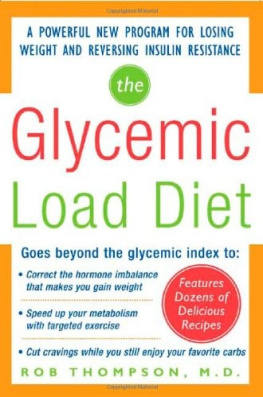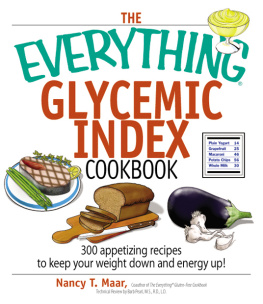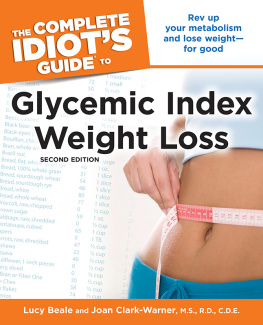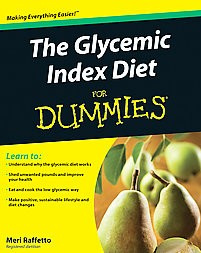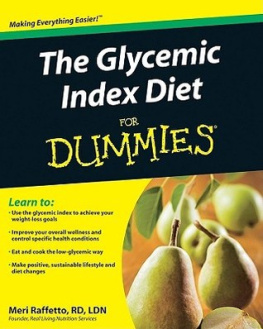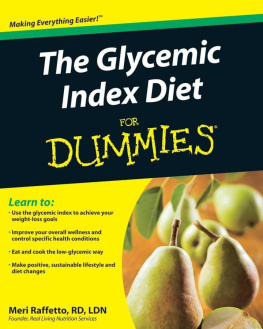the Glycemic Load Diet
A POWERFUL NEW PROGRAM FOR LOSING WEIGHT AND REVERSING INSULIN RESISTANCE
ROB THOMPSON, M.D.

Copyright 2006 by Robert Thompson. All rights reserved. Manufactured in the United States of America. Except as permitted under the United States Copyright Act of 1976, no part of this publication may be reproduced or distributed in any form or by any means, or stored in a database or retrieval system, without the prior written permission of the publisher.
0071487026
The material in this eBook also appears in the print version of this title: 0071462694.
All trademarks are trademarks of their respective owners. Rather than put a trademark symbol after every occurrence of a trademarked name, we use names in an editorial fashion only, and to the benefit of the trademark owner, with no intention of infringement of the trademark. Where such designations appear in this book, they have been printed with initial caps.
McGraw-Hill eBooks are available at special quantity discounts to use as premiums and sales promotions, or for use in corporate training programs. For more information, please contact George Hoare, Special Sales, at george_hoare@mcgraw-hill.com or (212)904-4069.
TERMS OF USE
This is a copyrighted work and The McGraw-Hill Companies, Inc. ("McGraw-Hill") and its licensors reserve all rights in and to the work. Use of this work is subject to these terms. Except as permitted under the Copyright Act of 1976 and the right to store and retrieve one copy of the work, you may not decompile, disassemble, reverse engineer, reproduce, modify, create derivative works based upon, transmit, distribute, disseminate, sell, publish or sublicense the work or any part of it without McGraw-Hill's prior consent. You may use the work for your own noncommercial and personal use; any other use of the work is strictly prohibited. Your right to use the work may be terminated if you fail to comply with these terms.
THE WORK IS PROVIDED "AS IS." McGRAW-HILL AND ITS LICENSORS MAKE NO GUARANTEES OR WARRANTIES AS TO THE ACCURACY, ADEQUACY OR COMPLETENESS OF OR RESULTS TO BE OBTAINED FROM USING THE WORK, INCLUDING ANY INFORMATION THAT CAN BE ACCESSED THROUGH THE WORK VIA HYPERLINK OR OTHERWISE, AND EXPRESSLY DISCLAIM ANY WARRANTY, EXPRESS OR IMPLIED, INCLUDING BUT NOT LIMITED TO IMPLIED WARRANTIES OF MERCHANTABILITY OR FITNESS FOR A PARTICULAR PURPOSE. McGraw-Hill and its licensors do not warrant or guarantee that the functions contained in the work will meet your requirements or that its operation will be uninterrupted or error free. Neither McGraw-Hill nor its licensors shall be liable to you or anyone else for any inaccuracy, error or omission, regardless of cause, in the work or for any damages resulting therefrom. McGraw-Hill has no responsibility for the content of any information accessed through the work. Under no circumstances shall McGraw-Hill and/or its licensors be liable for any indirect, incidental, special, punitive, consequential or similar damages that result from the use of or inability to use the work, even if any of them has been advised of the possibility of such damages. This limitation of liability shall apply to any claim or cause whatsoever whether such claim or cause arises in contract, tort or otherwise.
DOI: 10.1036/0071462694
To Kathy, Maggie, John, and "Nan"
Contents
Acknowledgments
I AM INDEBTED to my agent, Elizabeth Frost-Knappman, for encouraging me to write this book and shepherding it through its early stages. Natasha Graf, my editor at McGraw-Hill, was immensely helpful, bringing her considerable talents to bear on guiding me through the development and organization of the manuscript.
Molly Siple, M.S., R.D., provided exactly the recipe-writing touch I was seeking. Ms. Siple is nutrition editor at Natural Health magazine, chef extraordinaire, and author of several acclaimed cookbooks, including Low-Cholesterol Cookbook for Dummies (John Wiley and Sons, 2004), Healing Foods for Dummies (IDG Books, 1999), and Recipes for Change: Nutrition/Cookbook on Foods for Menopause (Dutton, 1996). She has taught at the Southern California Cordon Bleu School of Culinary Arts and continues to lecture and write articles on cooking and nutrition.
I would like to thank my longtime friend Lean Carroll for carefully reading and editing the manuscript and patiently sharing her thoughts with me. I am also indebted to my office staff, Nadine Warner, Lisa Gierlinski, and Charlene Brown, for so often going beyond the call of duty to make my life enjoyable. Most of all, I would like to thank my wife, Kathy, certainly for her editing skills but especially for her unwavering patience, encouragement, and support.
Introduction
W HEN I STARTED practicing medicine twenty-five years ago, I followed the party line. I recommended calorie counting and low-fat diets for weight loss and was usually disappointed by the results. People just kept gaining weight. Then, in the 1990s, some of my patients started ignoring warnings about fat and cholesterol and going on low-carb diets. The results were astonishing. Folks who had been unsuccessful at losing weight for years started shedding pounds more easily than they thought possible even as they ate generous amounts of rich food. Remarkably, their blood cholesterol and sugar levels looked better than ever. It was as if they had stopped ingesting a toxin that had been poisoning them for years. I became convinced that the low-carbohydrate approach had tremendous potential for helping people lose weight and regain their health. Indeed, as additional research came out, the medical establishment, mired in low-fat orthodoxy for decades, has come around to thinking the same way.
But just when medical science is focusing more attention on carbohydrates, the public's interest in low-carb diets is waning. People rushed to try the Atkins dieta radical low-carb regimen popularized in the 1970sand the South Beach diet, a sort of second-generation Atkins diet, but the programs didn't work the way they hoped. People lost weight but usually gained it back. Although these diets allowed plenty of rich food, they created irresistible food cravings. People just couldn't continue them for long. Disillusionment set in, and the low-carb craze began to die down.
In recent years, billions of dollars have been spent researching human body chemistry. Medical science knows much more about carbohydrate metabolism now than it did when the lowcarb movement began:
- Food scientists have developed a way of measuring the metabolic effects of different carbohydrates, called the glycemic index . This concept, only in its infancy when the low-carb movement began, has evolved into a powerful model, the glycemic load . This new way of looking at carbohydrates radically changes the low-carb approach to losing weight. It is the key to a natural weight-loss-promoting eating style that is satisfying and easy enough to follow for life.
- Scientists now know that most overweight people have a genetically influenced metabolic disorder called insulin resistance that makes them susceptible to weight gain from eating carbohydrates with high glycemic loads. Researchers have pinpointed the foods and behavior patterns that bring out this condition and can now target treatment toward relieving it.
- Recently, physiologists have discovered the metabolic quirk that causes insulin resistance. It's a disorder of the body's slow-twitch muscle fibers. What's exciting is that exercising these muscle fibers creates much less fatigue than exercising others.
These and other new concepts can help you harness the weight-loss power of carbohydrate modification and slow-twitch muscle activation with a lifestyle that's much easier to follow than previous weight-loss regimens. It really is possible to lose weight without "dieting," in the usual sense of the word, or engaging in strenuous exercise.
Next page
